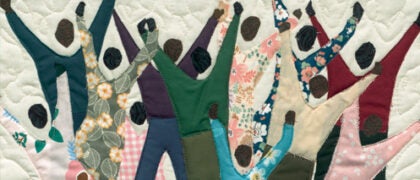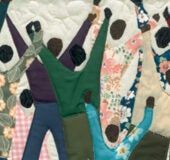Part I
LifeEkemini: Hey, y’all! Welcome to Truth’s Table. We are midwives of culture for grace and truth. I’m Ekemini.
Michelle: I’m Michelle.
Christina: And I’m Christina.
Ekemini: This table is built by Black women and for Black women. So welcome to the table, sistas! How y’all doin’!?
Michelle (to the tune of “My Life” by Erykah Badu): Wellllllllll, well!
Ekemini & Christina: (*cackle* *cackle* *cackle* *snort*)
Christina: I’m out here living in these life streets! This grown-up life is for suckas!
Ekemini: You ain’t lyin’, C! M, how you doing?
Michelle: As Langston Hughes said, “Life for me ain’t been no crystal stair.”
Christina: How you doing, E?
Ekemini: I’m yet holdin’ on! But I’m glad to be at the table with y’all. (In my Prince voice) Dearly beloved, we’re gathered here to get through this thing called life.
The Audacious Perseverance of Colorism
By Ekemini Uwan
Across cultures, darker people suffer the most. Why?
André 3000
Listen, sistas! Or better yet, read. I feel like I have the hardest subjects to write about in this book. I know that’s not true. All three of us have difficult topics we discuss on the show and now are unpacking in this book. But still, why do I have to talk about all the hard things?
Truthfully, out of all the chapters assigned to me, this is the one I dreaded writing the most. It’s the first chapter I attempted to write, and for a whole week, I stared at my computer screen with a blank Google document staring back at me. But I’m committed to truth-telling, and that includes telling the truth about myself. So it seems appropriate for me to name the source of my dread. There is power in naming it. This is my attempt at harnessing this power in ways that are productive.
I feel some trepidation about this subject because trauma lives here. Colorism is a scourge in our community here in America, on the African continent, and within the African diaspora. As a dark-skinned Black woman, I have been deeply impacted by colorism in innumerable tangible and intangible ways. And because of that, this topic requires a level of vulnerability that is uncomfortable, yet necessary.
Colorism is a complicated subject because of our varied experiences with it. Far too often, this conversation defaults to the oppression Olympics about valid yet anecdotal experiences from our light-skinned sistas at the table who have experienced the painful intrapersonal impact of colorism—bullying, caricatures, and taunts like “light, bright, and damn near white!” that call their Blackness into question. Some may cite these as an exception to disprove the rule. But outliers are just that—outliers. Exceptions do not disprove the rule, because colorism is not merely interpersonal; it is a structural reality.
Here is the rule of colorism: dark-skinned Black people are impacted in more significantly negative ways than light-skinned Black people. As bell hooks says, “There is a particular trauma that visits itself upon dark-skinned Black people that those of us who are lighter can’t even name.” The data bears this out. Denying this reality results in gaslighting dark-skinned Black people.
To be sure, there is real trauma regarding colorism that many of us have experienced, regardless of where we are on the color spectrum. However, this chapter is not School Daze—which is one of my favorite Spike Lee joints—in written form; we are not the “jigaboos” versus the “wannabees.” Just in case I’m dating myself with that Black culture reference, allow me to translate: this is not about dark-skinned Black folks versus light-skinned Black folks. Not every dark-skinned Black person hates their complexion, and not every light-skinned person thinks they are better than dark-skinned people.
I’m not interested in causing division, but I’m equally disinterested in denial. The facts are the facts. Colorism maps onto dark-skinned Black people especially in ways that are profoundly traumatic and discriminatory. On this we must agree if we are to uproot it from our minds and souls and dismantle it from our churches, systems, and other Black civic institutions.
How is it that I have been saved for over fifteen years and a member in a variety of different Black churches but have never heard one sermon about colorism? It is in the Bible, and it needs to be addressed within the Black church. We address racism with ease, but when it comes to colorism, mum’s the word. Could it be that the fingers rightfully pointed out there toward racists and racist systems suddenly start pointing back at us when it comes to colorism, because we are implicated in this intraracial dynamic? It’s not enough to be antiracist; we must also be anticolorists, because both evils are byproducts of white supremacy. And what is colorism but white supremacy persevering?
If you’ve been sitting at the table with us for some time now, you know I believe in defining terms. We’ve all encountered colorism—whether to our detriment or benefit, depending on where you are on the color spectrum. But I don’t want to assume that the term is understood by all of us.
Black feminist author Alice Walker coined the term “colorism” back in 1983 to describe the intraracial discrimination against people with darker-skinned complexions in preference for people with lighter-skin complexions. Dr. Sarah Webb, professor, researcher, and founder of Colorism Healing, defines colorism in this way: “Colorism is bias, prejudice, discrimination, or inequity based on the relative skin tone, hair texture, and facial features among persons of the same race. Colorism is an international phenomenon with regional and cultural differences. However, the commonality across cultures is that lighter skin is systematically privileged while darker skin is devalued or disadvantaged. Some people affected by colorism may even develop a dislike for their own skin and features.” As a consequence of colorism, dark-skinned people experience disparity when it comes to socioeconomic status, income level, healthcare, the criminal justice system, education, housing, jobs, and marriage markets.
Colorism is the offspring of white supremacy, and like its parent, it’s global: this phenomenon is at work within African, Asian, Caribbean, and Latine communities as well. Suffice it to say that non-Black people of color grapple with colorism, too. Nevertheless, for the purpose of this chapter, my focus centers on dark-skinned African American and African women’s experiences of colorism.
Within the American context, sociologists and historians locate the genesis of colorism in chattel slavery, particularly with its “one-drop rule.” Theologically, I posit that colorism predates that horrific time in history. But first, let’s explore what this one-drop rule did to us.
According to Dr. Yaba Blay,
In the United States, historically, a Black person has come to be defined as any person with any known Black ancestry. Although this definition has been statutorily referred to as the “one Black ancestor rule,” the “traceable amount rule,” and the “hypodescent rule,” it is more popularly known as the “one-drop rule,” meaning that one single, solitary drop of Black blood is enough to render a person Black. Said differently, the one-drop rule holds that a person with any trace of Black ancestry, however small or (in)visible, cannot be considered White. Unless that person has other non-White ancestry they can claim—such as Native American, Asian, etc.—they must be considered Black. A method of social order that began almost immediately after the arrival of enslaved Africans in America, the one-drop rule became a legal reality in the state of Virginia in 1705, and by 1910, it was the law of the land in almost all southern U.S. states. At a time when the one-drop rule functioned to protect and preserve White racial purity, Blackness was both a matter of biology and law. One was either Black or White. Period.
This rule animated the period of colonial enslavement. According to economists William Darity, Jr., Darrick Hamilton, and Arthur H. Goldsmith in their journal article “From Dark to Light: Skin Color and Wages Among African-Americans,” “During the era of slavery, light-complexioned blacks, often the offspring of white slave owners and enslaved Africans, were given preferential treatment through assignment to housework while darker-skinned blacks were typically assigned to outdoor or hard-labor tasks. Moreover, skin shade played a profound role in the acquisition of social status for black Americans following the abolition of slavery.”
Allow me to park here for a moment and say something about chattel slavery. When we talk about colorism in our community, we often reach back to the historical dichotomy between light-skinned enslaved women who worked in the homes of enslavers and dark-skinned enslaved women who worked the fields, because it’s a conspicuous historical example of colorism. However, it is important to wrestle with historical tension when recounting this dynamic, for there is an aspect of this history that is not as simple as it is often made out to be.
Copyright © 2022 by Christina Edmondson. All rights reserved. No part of this excerpt may be reproduced or reprinted without permission in writing from the publisher.






